|
EU import statistics show dramatic fall in tropical hardwoods during 2008
Newly released Eurostat data provides official
confirmation of anecdotal reports of a dramatic EU-wide
fall in imports of tropical hardwood products during 2008.
The downturn was felt in all corners of the EU and
affected just about the entire range of wood products
imported from tropical countries. In 2008, the volume of
EU-25 imports of hardwood logs, sawn, veneer, and
plywood from countries in the tropical forest zone was
down 27%, 23%, 11% and 14%, respectively.
Closer analysis of quarterly data indicates that the timing
of the downward trend varied by product group (Chart 1).
The decline in EU-25 imports of hardwood logs and sawn
from tropical countries set in at the start of 2008, falling
dramatically between the last quarter of 2007 and the first
quarter of 2008. The downturn in veneer imports began in
the second quarter of 2008, following a gentler but
nevertheless relentless slide. Hardwood plywood imports
held up well until the end of the third quarter of 2008 but
then tumbled dramatically in the last three months of the
year. The late response of the European plywood sector to
the changing demand situation seems now to be reflected
in particularly dire market conditions for this commodity
in the EU, with importers now desperate to offload
excessive stocks in the face of very slow consumption.
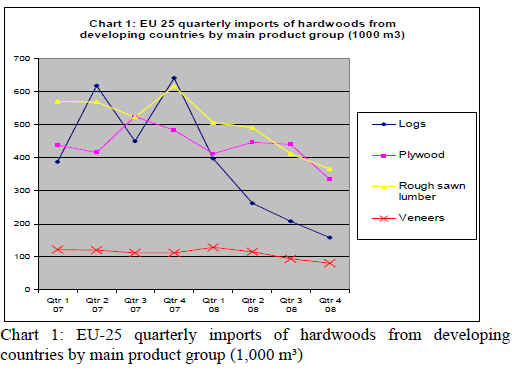
No European country has escaped the impact of the market
downturn, although there is some variation in the depth of
the recession in timber imports (Chart 2). The volume of
hardwood imports from tropical countries into France,
Italy, Spain, and Portugal fell particularly steeply during
the course of 2008. Imports into the UK fell more slowly,
although this may be due more to the delayed reaction of
the UK plywood sector than to any strength in underlying
consumption. Germany’s decline was more moderate,
partly because this market is already now less dependent
on tropical wood than other European countries and partly
due to more stable (but still unexciting) demand in
Germany’s joinery sector.
Imports of hardwoods from tropical countries into
Belgium and to a lesser extent, the Netherlands, held up
better than most other countries in 2008. Since both
countries are very significant as staging posts in the supply
of other European countries, the relative stability of their
imports during 2008 is just as likely to reflect changes in
purchasing practices in the wider European hardwood
market in the face of the recession as it is underlying
domestic consumption in the Benelux region. One impact
of the recession may have been to intensify the trend
towards increased reliance on little-and-often purchases
from the large concentration yards in the Benelux
countries and to reduce the numbers of European
companies engaged in direct imports of tropical wood.
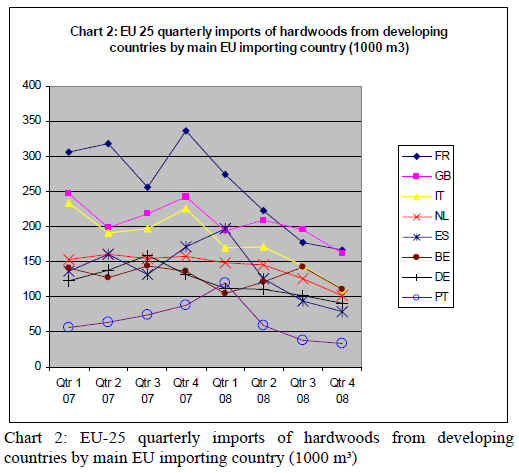
The fortunes of key tropical hardwood supplying countries
to the EU have also varied widely, although none could
claim to have had a particularly ‘good year’ in Europe
during 2008 (Chart 3). The volume of EU-25 imports of
hardwood products from China (mainly plywood) fell
from a peak of around 330,000 m³ in the third quarter of
2007 to less than 180,000 m³ in the last quarter of 2008.
Rising costs of labor and raw material combined with
quality and environmental concerns were undermining the
competitiveness of Chinese plywood products in the EU
market from the middle of 2007 onwards. The economic
downturn only added to these problems – although it is
worth noting that in pure volume terms, China remains a
very significant supplier of hardwood-based products to
the EU.
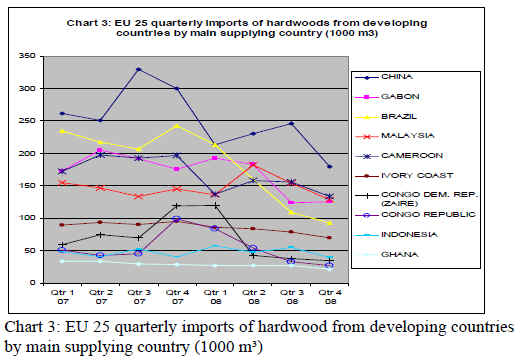
The decline in EU-25 imports of hardwood products from
Brazil (mainly plywood and sawn lumber) also fell very
dramatically from close to 250,000 m³ in the fourth quarter
of 2007 to less than 100,000 m³ in the last quarter of 2008.
During the whole of 2008, the volume of EU-25 imports
of hardwood plywood and sawn lumber from Brazil were
down respectively 44% and 15%. This reflects both
difficult supply conditions in the Brazilian hardwood
sector as well as slowing European consumption.
EU-25 imports from African countries during 2008 saw
some significant declines, although less dramatic than
those experienced from Brazil and China. European log
and sawn imports from Gabon were down 19% and 11%
respectively on the previous year, although these declines
were partly offset by a 15% rise in EU imports of plywood
from Gabon, an effect of the new inward investment in
processing capacity in the country in recent times. EU-25
imports from Cameroon followed a similar path, with
significant declines in volumes of logs (-45%) and sawn (-
19%), but a rise in volumes of plywood (+9%). EU-25
hardwood imports from the Congo Democratic Republic
(logs and rough sawn), having risen dramatically at the
end of 2007, fell to much lower levels from the end of
March 2008 onwards. EU-25 imports of logs and rough
sawn from the Republic of Congo fell consistently
throughout 2008, partly offset by a rise in imports of
veneer from the country. EU-25 imports of hardwood
(mainly sawn lumber) from Côte d’Ivoire and Ghana fell
consistently during the course of 2008, ending the year
around 17% down on 2007.
Malaysian hardwood suppliers performed better than most
of their competitors in the European market in 2008. EU-
25 imports of Malaysian sawn lumber in 2008 were down
only 5% on the previous year while imports of Malaysian
plywood were actually up 14%, with large increases in
sales to Belgium, Netherlands, and Italy. This reflects both
the mounting problems in Chinese plywood supply and the
development of new FSC-certified combi-plywood
products in Malaysia combining tropical hardwood face
with a New Zealand radiata pine core.
Meanwhile EU-25 hardwood imports from Indonesia
(mainly plywood and mouldings) remained relatively
stable throughout the course of 2008, although a shadow
of their former self at well below 200,000 m³ for the whole
year.
During 2008, EU-25 imports of hardwood flooring
products from developing economies reached 45.8 million
m², a 2% decline on the previous year. China consolidated
its position of dominance in the sector, contributing 29.5
million m³ of European imports, up 10% on the previous
year. EU-25 imports of hardwood flooring from most
other developing countries declined, including from
Indonesia (-12%), Brazil (-20%), Malaysia (-24%),
Thailand (-22%) and Côte d’Ivoire (-22%).
A comprehensive breakdown of EU-25 imports of
hardwood products from countries in the tropical zone
during 2008 by leading supply country and European
Member State is shown in the following tables. European
imports of all hardwood from countries that are fully or
partially in the tropical zone are included. In some cases a
significant proportion of these hardwoods may be of
temperate origin, particularly in the case of China. The
EU-25 group of countries includes all members of the EU
with the exception of Romania and Bulgaria (which only
joined the EU on 1 January 2007). Data is compiled from
Eurostat data supplied by Business Trade and Statistics
Ltd. Forest Industries Intelligence Limited analyzed the
data to remove inconsistencies.
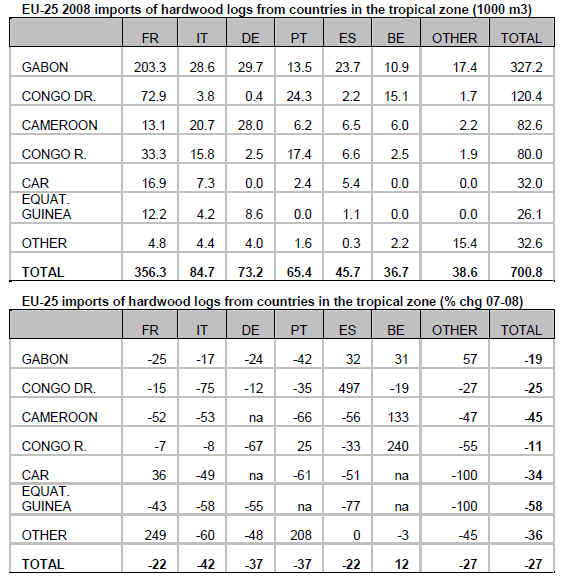
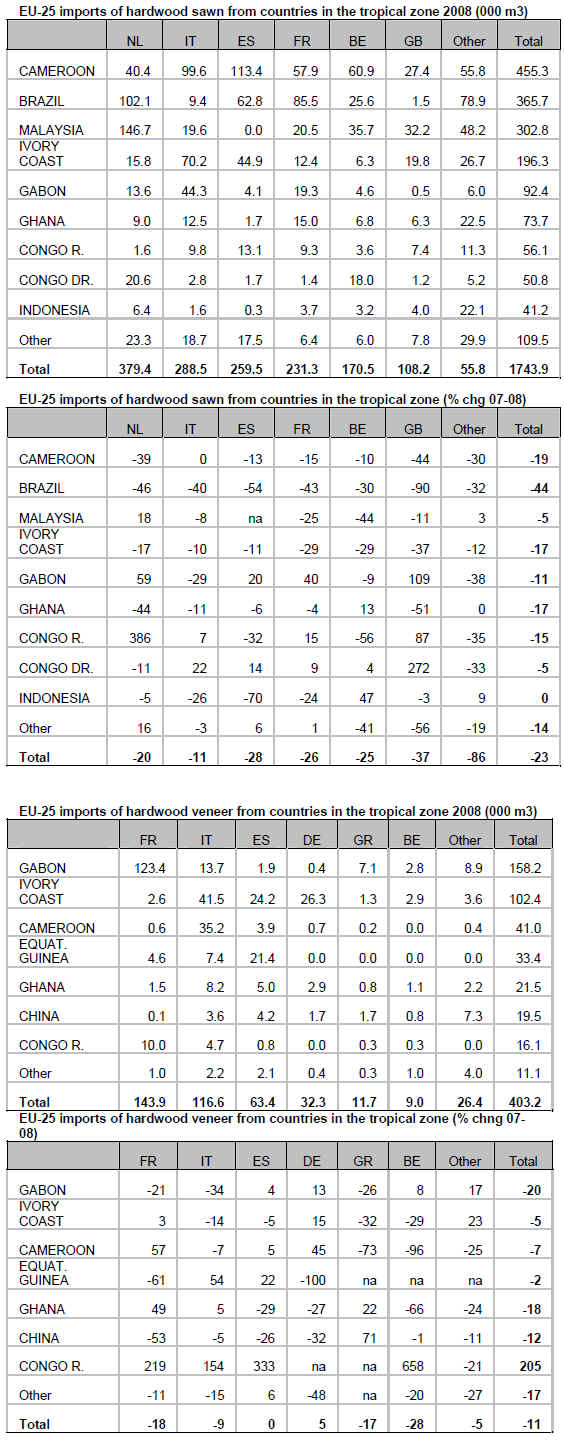
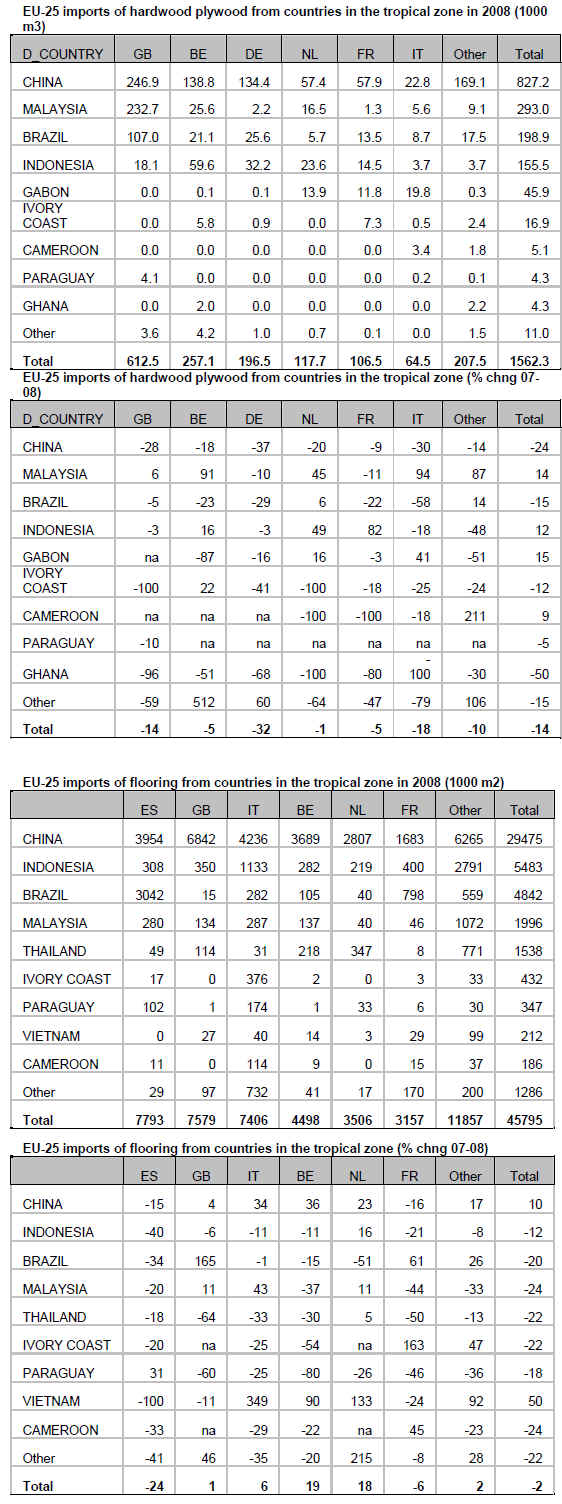
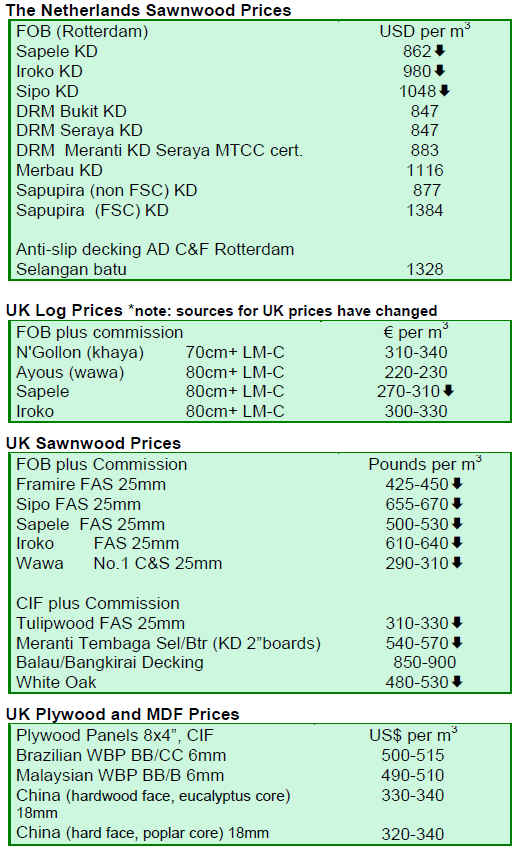
|